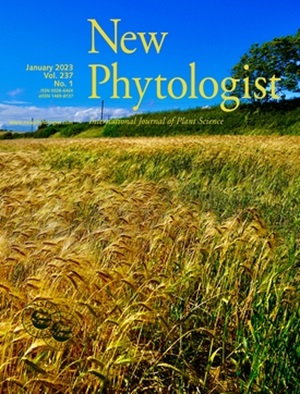Soil pH-dependent nitrogen stimulation of plant biomass: magnesium and calcium as key constraints
IF 8.3
1区 生物学
Q1 PLANT SCIENCES
引用次数: 0
Abstract
- Anthropogenic nitrogen (N) deposition can alleviate N limitation and stimulate plant growth in many terrestrial ecosystems. While theoretical models often emphasize phosphorus limitations as a constraint on this positive N effect, the impact of N-induced magnesium (Mg) and calcium (Ca) deficits due to soil acidification has been largely overlooked.
- Here, we synthesized data from 243 experiments across diverse terrestrial ecosystems to investigate the role of Mg and Ca in plant biomass responses to N addition.
- We found that the effect of N addition on aboveground biomass (AGB) shifted from neutral in low pH (≤ 4.5) to positive in medium (4.5–7.5) and high pH (> 7.5) soils. By contrast, belowground biomass (BGB) responses to N addition were independent of soil pH, leading to asymmetric increases in AGB and BGB. These variations in biomass accumulation across pH levels were primarily explained by changes in foliar Mg and Ca concentrations, which were negatively affected by N addition in low-pH soils but remained stable in medium and high-pH soils.
- Our findings underscore the critical role of Mg and Ca in modulating plant responses to N fertilization, providing new insights for improving Earth system models and better predicting climate–biosphere feedback.
求助全文
约1分钟内获得全文
求助全文
来源期刊

New Phytologist
生物-植物科学
自引率
5.30%
发文量
728
期刊介绍:
New Phytologist is an international electronic journal published 24 times a year. It is owned by the New Phytologist Foundation, a non-profit-making charitable organization dedicated to promoting plant science. The journal publishes excellent, novel, rigorous, and timely research and scholarship in plant science and its applications. The articles cover topics in five sections: Physiology & Development, Environment, Interaction, Evolution, and Transformative Plant Biotechnology. These sections encompass intracellular processes, global environmental change, and encourage cross-disciplinary approaches. The journal recognizes the use of techniques from molecular and cell biology, functional genomics, modeling, and system-based approaches in plant science. Abstracting and Indexing Information for New Phytologist includes Academic Search, AgBiotech News & Information, Agroforestry Abstracts, Biochemistry & Biophysics Citation Index, Botanical Pesticides, CAB Abstracts®, Environment Index, Global Health, and Plant Breeding Abstracts, and others.
 求助内容:
求助内容: 应助结果提醒方式:
应助结果提醒方式:


